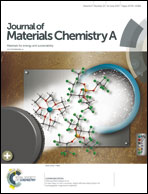Rational design of N-doped carbon nanobox-supported Fe/Fe2N/Fe3C nanoparticles as efficient oxygen reduction catalysts for Zn–air batteries†
Abstract
Zn–air battery, as a low cost, high energy density, and safe energy device, has received significant attention in recent years. However, its wide application has been hindered due to the low oxygen reduction reaction (ORR) activity in air electrodes without excellent catalysts. Herein, N-doped porous and highly graphitic carbon nanobox-supported Fe-based nanoparticles (Fe–N-CNBs), which were synthesized from fructose, NH3, and FeCl3 by a self-propagating high-temperature synthesis (SHS) process followed by a heat treatment process, were used as ORR catalysts. Fe–N-CNBs calcined at 600 °C (Fe–N-CNBs-600) showed higher ORR activity (onset and half-wave potentials of 1.03 and 0.85 V vs. RHE, respectively), better electrochemical stability, and higher methanol tolerance than Pt/C under alkaline conditions. The outstanding ORR performance of Fe–N-CNBs-600 was attributed to the synergistic effect of Fe, Fe2N, and Fe3C nanoparticles, which was unambiguously confirmed by HRTEM and XRD characterization. Furthermore, Fe–N-CNBs-600 also exhibited higher electrochemical properties than the currently used expensive Pt/C catalyst in Zn–air batteries.



 Please wait while we load your content...
Please wait while we load your content...